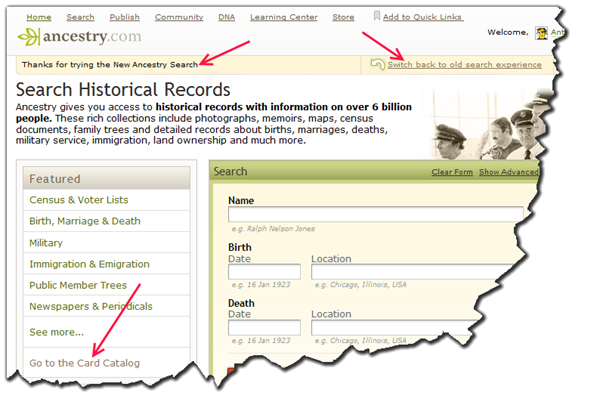Archives
The Next Step: Finding a Database for You
April 25, 2013 by EJRT
Filed under Archives, Articles, Genealogy Research Resources, Online Tools
 Genealogy is all about connections — the connections between you and your ancestors, between your ancestors and their historical context, and amongst all of the facts and records that together help to weave the tartan of your past.
Genealogy is all about connections — the connections between you and your ancestors, between your ancestors and their historical context, and amongst all of the facts and records that together help to weave the tartan of your past.
Just as no one resource can provide all your answers, no one tool will solve all your problems. For every piece of the puzzle you need to improvise a new solution — so, to avoid spinning your wheels against a brick wall it’s best to get acquainted with all of your options.
Genealogy Beginner can get you started with knowledge of all the best practices and methodology, but where do you go from there? An easy first step is an online service like Ancestry.com, where you can easily search birth, marriage, and death Records
, browse their Obituary Collection
, and then start your free family tree
to keep it all organized.
There are many such services, each with their own unique archives and site features. Ancestry.com is perhaps more user-friendly collaborative than other services, in that once you enter in some basic information the service actively works to fill in the blanks, drawing upon both public records and the work of other members. If the suggestions sound right, just click to add them to your own tree — which then becomes part of the cycle, as the more complete your tree the more the site’s search engine has to work with.
The best part of services like this is that they give you a start in collecting your thoughts without asking for much of an investment, either in terms of time or money. In the case of Ancestry.com, the basic subscription is fairly inexpensive; to get overseas records you will need to upgrade, which is a little more. If you decide it’s not what you need, you can just cancel and try another service; all you’re out is maybe ten, fifteen bucks. If you cancel within 14 days, there’s no charge at all.
What they’re banking on is the appeal of their interface and search tools — and you know what? It’s a good bet. What would be hours of manual, tedious research is reduced to a few seconds of behind-the-scenes pattern-matching. There is of course a limit to any online database, and the wow value here should be over by the time your trial period is up — but even for an experienced genealogist the elegance and dynamism of their tools can be hard to give up.
So, it’s worth a shot. Try a membership at Ancestry.com, and if it’s not your thing then at least you’ll better know your options. If it is, there’s one more tool under your belt.
Genealogy: Getting to Know Your Ancestors
June 14, 2012 by ramona
Filed under Archives, Family History, Genealogy groups, societies and organizations, Latest News
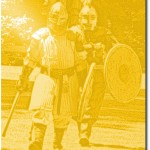 The Merriam Webster Dictionary gives a definition of genealogy as:
The Merriam Webster Dictionary gives a definition of genealogy as:
- an account of the descent of a person, family, or group from an ancestor or from older forms
- the study of family pedigrees
Strictly speaking, this is true; it is certainly a good definition of the process and an accurate descriptor of the intent with which genealogy is first approached. However, to those of us who have spent any length of time on this addictive hobby, the study of our ancestors begins to take on new meaning.
It is not long after family tree research begins that the dry definitions become inadequate. As we work our way through record after record, learning piecemeal the details of our ancestors lives we begin to feel we are getting to know them as individuals.
For some, the genealogical aspects of family history research are not enough. We want to get to know our forefathers on a deeper level. Become more familiar with their day-to-day lives.
If you count yourself among those wishing for a deeper understanding of your generations past, there are a number of activities you can participate in; activities that will allow you to experience your family history in a very real way.
Recreationists
Pick almost any period in history and you will find a group of people actively recreating the era. Living history groups include the activities, dress and tools of the eras they portray to give participants the sense of stepping back through time. Recreationists are not re-enactors; they are not scripted nor are they involved in recreating specific events. Member’s interests can include clothing styles, pastimes, cookery and artisanship, everything that would help create a feeling of every day life in bygone days. It is not at all surprising that among their ranks you find many genealogists and family historians.
Living History Groups
From late 20th century groups like “The 20th Century Revisited” A UK based group recreating scenes and events from various parts of the later 20th Century including WW2 resistance, and 1970 British Army of the Rhine (BAOR) or “Paper Dolls” An international group made up of female members who portray military and civilian life during World War Two. From hometown sweethearts, Women’s Land Army, French Resistance, American Red Cross, Women’s Army Corps. These groups offer an opportunity to learn what it was like for ancestors who lived during the great wars; both on and off the battlefield.
If you are more interested in the events of the 19th century The Living History Society of Minnesota members can attend workshops and participate in activities designed to increase their knowledge of mid 19th century life. For those whose Gr,Gr,Gr, Grandfathers heeded the familiar call of “Go West young Man” the Mojave Muleskinners have several branches across the US, Canada and the UK where you can immerse yourself and learn about life in the old west.
If you can trace your family tree to medieval times, a living history group from the Middle Ages may be more suiting. The Society for Creative Anachronism (SCA) is an international organization with over 30,000 members residing in countries around the world. One of the best things about this group is that you will find a mix of cultures from Viking to Italian to Middle Eastern. Members attend events such as tournaments, royal courts, feasts, dancing, various classes, workshops and more. The SCA is a group that lets you explore all of the European lines in your family tree.
If you want to know more about how living history groups can help enrich your genealogy and family history or how to find a group near you, just post a question to the Genealogy in General board on the Genealogy Beginner forums.
Genealogy Brick Walls: Look In the Unlikely Places
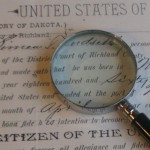 Hitting a brick wall in your family tree is an extremely frustrating experience for every family tree enthusiast from the novice to the advanced. Especially after, you have spent hours combing through all of the obvious records. When you have already checked the church records, civil records, obituaries, newspaper archives, immigration records and census…do not give up. Just realize that it is time to pull out your shovel and start digging deeper.
Hitting a brick wall in your family tree is an extremely frustrating experience for every family tree enthusiast from the novice to the advanced. Especially after, you have spent hours combing through all of the obvious records. When you have already checked the church records, civil records, obituaries, newspaper archives, immigration records and census…do not give up. Just realize that it is time to pull out your shovel and start digging deeper.
In short, after you have looked in all of the likely places the only places left to check are the unlikely ones.
Genealogy in the Unlikely Places
The unlikely places are usually the ones you ruled out your first time through. You may be very surprised at how much information you can find by looking in records that seemed irrelevant or illogical to your family tree research.
Finding Ancestors in Land Records
You have ruled this out because your ancestor did not own land, but did you know you could still find the record of a lease for a tenant farmer or rental agreement for your Great, Great Grandma’s city home.
Your Family Tree and Depositions
You have probably already checked the immigration records to see if your ancestors changed their name upon landing in the new country. However, did you know that many immigrants did not change their names until they were already naturalized citizens? If your ancestor decided to change their name after becoming a naturalized citizen, you would find this information in court records as depositions.
Name changes of this type often happened because immigrants felt a foreign name made their lives more difficult in their new home. If your ancestor has pulled a disappearing act, searching depositions for name changes would be a good place to start.
Historical Societies and Genealogy
Your local historical society (or the local historical society where your ancestor lived) may hold the clues you have been looking for. Historical societies are notorious for holding little known documents and unpublished works that are only listed within their collection.
One Family Tree Search is Never Enough
Newspaper archives may be something you have already checked. Nevertheless, you should try them again. Many genealogy beginners give up far too soon on this information source by stopping at a single search type. Any search of a newspaper archive should be undertaken with three search strategies.
- Search by Name
- Search by Date
- Search by Location
A newspaper can hold so much information in a single issue that not all names are indexed. That is why a three-tier search is necessary.
Although sometimes a brick wall in your genealogy research is due to records being lost in fires and wars, poor preservation and/or the records were simply not kept. The biggest problem with brick walls is that family enthusiasts either give up too soon or just don’t know where to look next. Should you have any questions or want a little extra help tackling your brick wall, please feel welcome to post your questions to the Ask a Genealogist forum. Genealogy Beginner looks forward to hearing from you.
Image Credit: Ramona Hartley
Facebook Drawing – Sylvania 2GB MP3 Player/ Voice Recorder
 We’ve just reached 100 Facebook fans and to mark the occasion we’re doing to do a drawing among those who have joined the FB Genealogy Beginner community.
We’ve just reached 100 Facebook fans and to mark the occasion we’re doing to do a drawing among those who have joined the FB Genealogy Beginner community.
Click “Like” or add a “Comment” on our genealogy Facebook page. We’ll do the drawing Monday 12/05/11 and mail this great Synvania 2GB MP3 Player/ Voice Recorder to the lucky winner.
We think you should use this to whisper verbal notes excitedly from the library stacks as you dictate the details of a previously unknown ancestor. However, you might find the MP3 player a great way to bring your music along on your next walk. You could give it away as a gift for the holidays but we think this is something you’ll want to keep for yourself.
Regardless, make sure you leave a comment or “like” this post on FB and include yourself in the drawing. We’ll announce the winner on Monday.
Photo Source: Woot.com
Commission Recommends $2.15 Million in Grants for Document Editing and Archival Projects
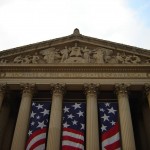
A press release from the National Archives November 20, 2008, published the results of a November meeting of the National Historical Publications and Records Commission (NHPRC).
The recommendations made at the November meeting, were to approve grants in the amount of $2.15 million that would encompass 23 projects across 13 states as well as the District of Columbia
New National Personel Records Center
 National Archives to Dedicate New National Personnel Records Center Annex Facility
National Archives to Dedicate New National Personnel Records Center Annex Facility
Valmeyer, IL . . . The National Archives and Records Administration will formally dedicate its new National Personnel Records Center (NPRC)Annex Facility in the Rock City Admiral Parkway development (1411Boulder Boulevard, Valmeyer, IL) at 1:30 p.m. on Friday, October 24,2008. Speakers scheduled to participate include
U.S. Congressman Jerry Costello (D-IL, 12th), Illinois State Senator Dave Luechtefeld (R-IL,58th), Illinois State Representative Dan Reitz (D-IL, 116th), Monroe County Board of Commissioners Chairman Dale Haudrich, Monroe County Clerk Dennis Knobloch, and Valmeyer Mayor Howard Heavner. The event will also feature a flag-raising ceremony and refreshments. The ceremony isby invitation only, and is open to the working press.
The Valmeyer Annex is located in a retrofitted limestone cave. Theapproximately 400,000 square foot building has a total storage capacityof nearly two million cubic feet of records. The building will primarilyhouse temporary records-mostly military medical treatment records andrecords for civilian Federal personnel who retired after 1973. The moveto the new building is scheduled to be completed by November 2009
The National Archives recently announced that it will also lease a new,built-to-suit facility at 1829 Dunn Road in St. Louis County as its main building. This building will house approximately 2.3 million cubic feet of archival and permanent records, including Official Military Personnel Files and Official Personnel Folders of Federal civilian employees.Together, the Dunn Road facility and the Valmeyer Cave Annex will replace the current NPRC buildings currently located at 111 Winnebago Street and 9700 Page Avenue in St. Louis.
“The Valmeyer Annex will allow us to securely and cost-effectively store these important records for the military and civilian personnel who have so ably served our country,” said NPRC Director Ronald Hindman. “Together with the Dunn Road building, these two facilities will allow us to fulfill our mission of protecting and providing ready access to these records.”
Admiral Parkway, Inc, developed the site. The National Archives and Admiral Parkway, Inc. have entered into a 20-year lease for the building.
The press is invited to cover the ceremony. The site is located at 1411Boulder Boulevard. The ceremony begins promptly at 1:30 p.m. Directionsfrom the Jefferson Barracks Bridge: Drive I-255 East crossing intoIllinois. Merge onto IL-3S via Exit 6 toward Columbia, IL. Take PalmerRoad exit toward Quarry Road. Turn right onto Palmer Road/CR-6S whichbecomes Bluff Road and travel approximately 14 miles. Turn left ontoQuarry Road and follow it to 1411 Boulder Boulevard.
Ancestry.com’s Card Catalogs
Ancestry.com’s Card Catalogs are a fantastic resource for helping all of you genealogists and family history buffs locate documents for your generations past. Sorting through the immense amount of information available is a task that can be extremely overwhelming. The card catalogue will help simplify the process; it will let you search in the same way your local libraries’ card catalogue does.

You can search by:
Name,
Location
Keyword
If you have any troubles don’t worry; The Ancestry Insider has done it again with another enormously helpful article; this one is a fantastic “How-To” post about Ancestry.com’s Card Catalogs.
Complete with excellent screen shots, this short but sweet step by step guide walks you through both the new and old catalogue search functions and will have you searching like a pro in no time.
Old Search

New Search
Notice: The Ancestry Insider is independent of Ancestry.com and FamilySearch.org. The opinions expressed herein are his own. Trademarks used herein are trademarks or registered trademarks of their respective owners. The name Ancestry Insider designates the author’s status as an insider among those searching their ancestry and does not refer to Ancestry.com. All content is copyrighted unless designated otherwise.
(Notice and images from The Ancestry Insider.)
Cemetery for Cubs Fans
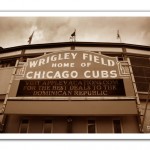 You read that correctly, yes, a cemetery for Cubs Fans. That is the latest news from Southern Graves. It seems however that everyone is a-buzz with this news. In an article from the Chicago Tribune:
You read that correctly, yes, a cemetery for Cubs Fans. That is the latest news from Southern Graves. It seems however that everyone is a-buzz with this news. In an article from the Chicago Tribune:
“Cubs fans hoping for a World Series title before they die at least can be buried in a place that looks like Wrigley Field when they do.”
Beny Lipsman for the Chicagoist writes in his article “Pushing Ivy?”
“Marriage may be til death do us part, but apparently allegiances to one’s baseball team last even longer.”
Filed under Odd News the article titled “Cemetery gives Cubs fans burial site” from United Press International covers the story by saying, “Ground was broken Friday for a burial site at a Chicago cemetery modeled after a portion of landmark Wrigley Field to accommodate die-hard Chicago Cubs fans.” This could definitely make for some interesting genealogy research in years to come.
To read the full article visit Southern Graves
…
Where to Next?
…
SPECIAL PROGRAMS HIGHLIGHT NATIONAL ARCHIVES RECORDS IN OCTOBER
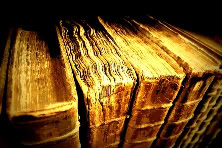
October at the National Archives sees a chain of programs that will be of great interest to genealogists. This series of programs – that are open to the public and free – will highlight records from its holdings.
Among the programs listed:
Introduction to Genealogy
This is the first of a series of monthly lectures that will cover basic genealogy research and researching techniques.
Access to Archival Databases (ADD) for Genealogists
This program introduces genealogists to the National Archives electronic records and will instruct attendees in their use through the (ADD) or Access to Archival Databases online resources.
Help! I’m Stuck
Will be a fantastic program for beginning Genealogists who are not sure where they should begin. This program addresses questions like “IS there a problem that has you stumped?” and “Would you like to explore new directions in your research?
For the dates and times of these programs or for additional information please visit:
http://www.archives.gov/dc-metro/know-your-records/
…
Where to Next?
Blank Family Tree with Step-by-Step Instructions
…
08-145
Ancestry’s Mythical OneWorldConnect
Ancestry.com Dendrology 101: Ancestry’s Mythical OneWorldConnect
According to one competitor’s website, Ancestry.com has a tree system called OneWorldConnect. See the detail from their website, below. Sorry, guys. There is no such tree system. One wonders if they were trying to reference OneWorldTree or WorldConnect. However, OneWorldTree is, to use their terminology, an “Internet-Based Collective Family Tree” (albeit read-only). And WorldConnect is “a collection of family trees.”
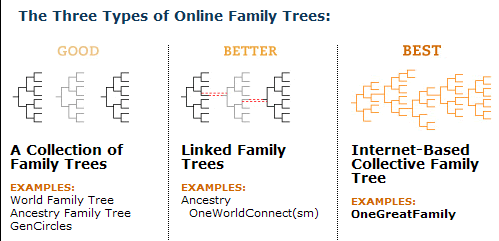
A competitor examines Ancestry’s non-existent OneWorldConnect
In my opinion, an example of a “Linked Family Tree” is GenCircles Global Tree and their SmartMatching. But this isn’t meant to be an inventory of all Internet tree systems. Otherwise I’d take the time to show you an example of GenCircles SmartMatching for George Washington.
In conclusion, be assured that Ancestry.com has no OneWorldConnect and has no Linked Family Tree.
…
Where to Next?
Blank Family Tree with Step-by-Step Instructions
…

